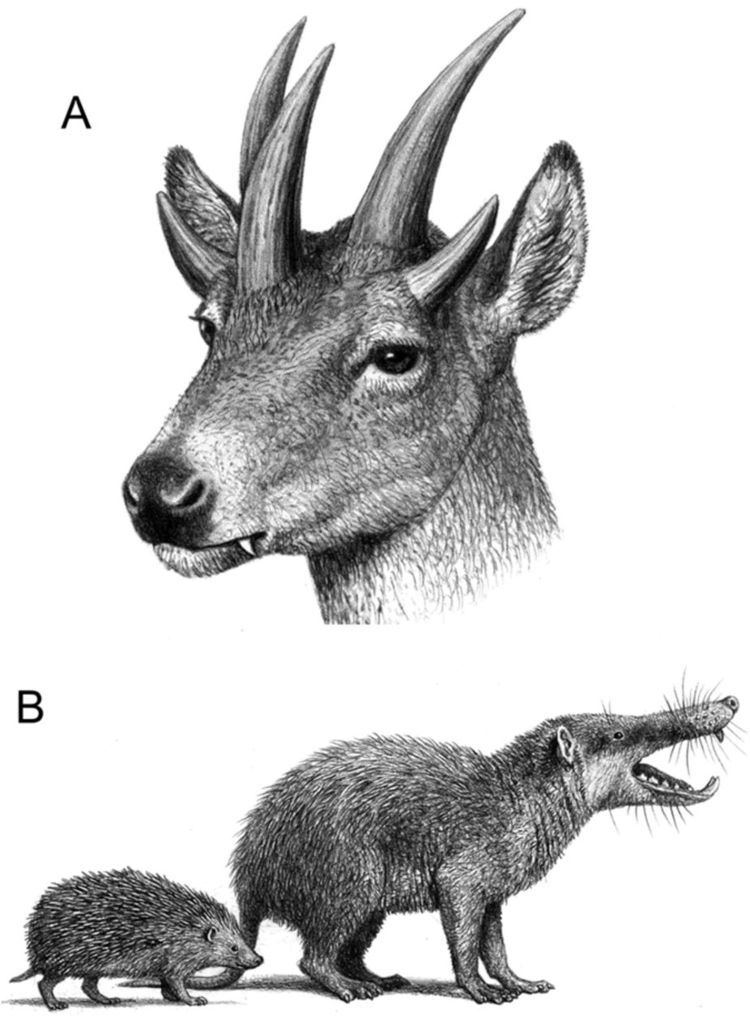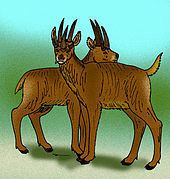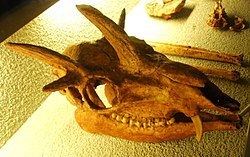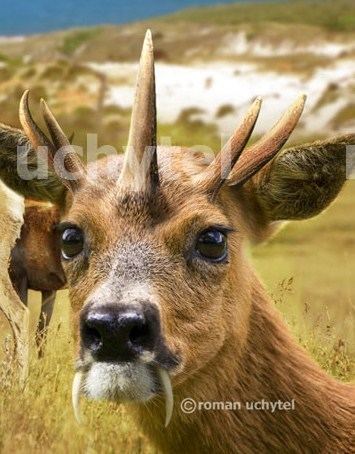Family †Hoplitomerycidae Rank Genus | Phylum Chordata Order Even-toed ungulate | |
 | ||
Similar Deinogalerix, Hoplitomerycidae, Even‑toed ungulate, Candiacervus, Azhdarcho | ||
The extinct five-horned prongdeer Hoplitomeryx matthei with its sabrelike ('moschid' type) upper canines lived on the former Gargano Island during the Miocene and the Early Pliocene, now a peninsula on the east coast of South Italy.
Contents

Its fossilized remains were retrieved in the late sixties and subsequent years from reworked reddish, massive or crudely stratified silty-sandy clays (terrae rossae), which partially fill the paleo-karstic fissures in the Mesozoic limestone substrate and that are on their turn overlain by Late-Pliocene-Early Pleistocene sediments of a subsequently marine, shallow water and terrigenous origin. In this way a buried paleokarst originated.
The fauna from the paleokarst fillings is known as Mikrotia fauna after the endemic murid of the region (initially named "Microtia", with a c, but later corrected, because the genus Microtia was already occupied). Later, after the regression and continentalization of the area, a second karstic cycle started in the late Early Pleistocene, the neokarst, which removed part of the paleokarst fill.

Description

Hoplitomeryx was a deer-like ruminant with a pair of pronged horns above each orbit and one central nasal horn. Hoplitomerycids are not the only horned deer; before the appearance of antlered deer, members of the deer family commonly had horns. Another left-over of this stage is Antilocapra of North America, the only survivor of a once successful group related to Bovidae.

The diagnostic features of Hoplitomeryx are: one central nasal horn and a pair of pronged orbital horns, protruding canines, complete fusion of the navicocuboid with the metatarsal, distally closed metatarsal gully, a non-parallel-sided astragalus, and an elongated patella.
Species

The Hoplitomeryx skeletal material forms a heterogeneous group, containing four size groups from tiny to huge; within the size groups different morphotypes may be present. All size groups share the same typical Hoplitomeryx features. The different size groups are equally distributed over the excavated fissures, and are therefore not to be considered chronotypes. The hypothesis of an archipelago consisting of different islands each with its own morphotype cannot be confirmed so far. The tiny and small specimens show insular dwarfism, but this cannot be said for the medium and huge specimens.
The situation with several co-existing morphotypes on an island is paralleled by Candiacervus (Pleistocene, Crete, Greece). Opinions about its taxonomy differ, and at present two models prevail: one genus for eight morphotypes, or alternatively, two genera for five species. The second model is based upon limb proportions only, but these are invalid taxonomic features for island endemics, as they change under influence of environmental factors that differ from the mainland. Also in Hoplitomeryx the morphotypes differ in limb proportions, but here different ancestors are unlikely, because in that case they all ancestors must have shared the typical hoplitomerycid features. Interestingly, in Candiacervus as well as in Hoplitomeryx, the largest species is as tall as an elk, but gracile and slender.
The large variation is instead explained as an example of adaptive radiation, starting when the Oligocene ancestor colonized the island. The range of empty niches promoted its radiation into several trophic types, yielding a differentiation in Hoplitomeryx. The shared lack of large mammalian predators and the limited amount of food in all niches promoted the development of derived features in all size groups (apomorphies).
